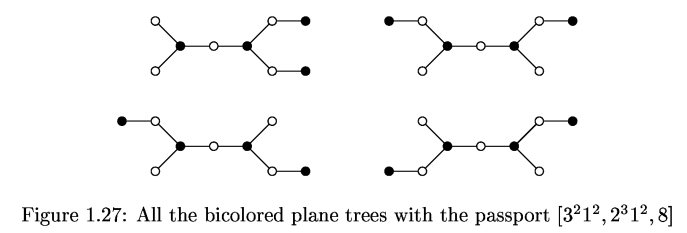This will be a series of questions, a few of which have been troubling me for quite a while now. Before I jump right in, let me first introduce a few notions which I will assume.
(Note: All of these can be found in Lando and Zvonkin's book "Graphs on Surfaces and their Applications", readers familiar with this may skip to the main questions below.)
- A dessin d'enfant is a map on a Riemann surface $X$ of a given genus $g$, which arises from finite coverings $X \rightarrow \mathbb{P}^1\mathbb{C}$ unramified outside $0,1,\infty$. To such a covering, we associate black vertices of the dessin to be the inverse images of 0, white ones to be the inverse images of 1, and the edges of the dessin are the components of the preimage of the segment $(0,1)$, and the faces are the components of the inverse image of the complement of $(0,1)$. The valency of each vertex is the degree of ramification of the point of which it is the pre-image of.
- The morphism (which is unramified outside $0,1,\infty$) which gives the dessin is called a Belyi morphism.
- To each dessin, we get two monodromy permutations, the first two show the local cyclic order of edges around vertices of the same colour, and one more is chosen such that the product of the three is identity. The cycle structure of these three permutations constitutes what is called a passport.
For this question, our dessins are all of genus 0, have exactly one face, and that is the unbounded face containing infinity. The corresponding Belyi function is simply a complex polynomial with atmost two critical points, which is called a Shabat Polynomial. The passport is now called valuable tree passport and it gives the cycle structure of the two permutations of the black and white vertices respectively. In this case, the third permutation is trivial, as so its not shown in the passport.
The bicoloured plane tree along with its passport is called a "hypermap". Now, my questions are as follows:
- My friend and I were trying to draw a tree given a passport via SAGE, the open source math software. But we quickly realized that it was pretty difficult to draw. I wanted to ask if you could tell me how to draw the trees, specifically about which math software package can be used. I understand Maple is widely used, so I'd be grateful for a specific Maple method which can be used for this.
- Does TikZ work for drawing trees in LaTeX?
- Since a passport may give more than one tree, I'm curious to know if all the trees which belong to a particular family can be drawn if just their passport is known. I ask this because after I tried to draw the trees corresponding to [3311,22211,8] by hand, (8 is the number of edges), I realized that I drew the "mirror image" of the first tree on paper, and that wasn't there in the list given in the book. Why isn't the mirror image of the first tree also shown?

- As in the picture above, when the dessins are drawn, why are they shown in the form that they are? Why not say, draw all "leaves" perpendicular to the main branch?
Thanks a lot in advance!
